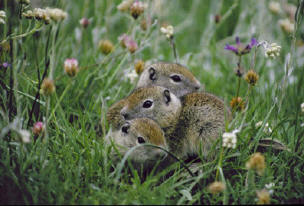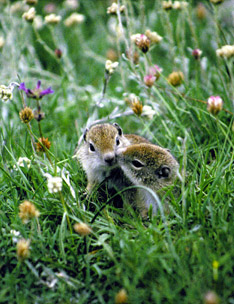Belding's Ground Squirrels
Jill Mateo, Ph.D, University of Chicago

The eastern Sierra is home to a wide variety of wildlife. While bears and fish may get the most attention from locals and visitors alike, a different animal has been the focus of my research for the last decade. Belding’s ground squirrels are highly social animals found in meadows, sagebrush, and of course, campgrounds throughout the high Sierra.
Many ground-squirrel species hibernate for most of the year, spending only 3-4 months above ground in the summer. They mate shortly after hibernation, with males fighting vigorously for access to females and some males sustaining fatal injuries. About a month later, a female will give birth to a litter of 5-8 pups, which she rears by herself in an underground natal burrow for about 25 days. Her pups are vulnerable to predation from ground predators such as snakes and weasels, and from infanticidal squirrels. Not surprisingly, mothers guard their natal burrows vigilantly, scent-marking their territories and chasing away intruders.
 When juveniles first venture above ground they are preyed on by both
aerial and terrestrial predators, with only 40-60 % of juveniles
surviving until fall. For the next two months, they have to disperse
from home, establish a hibernaculum and avoid being eaten, in addition
to gaining sufficient body fat to get them through their first
hibernation. This is not an easy task, and up to 60% of juveniles starve
during their first winter.
When juveniles first venture above ground they are preyed on by both
aerial and terrestrial predators, with only 40-60 % of juveniles
surviving until fall. For the next two months, they have to disperse
from home, establish a hibernaculum and avoid being eaten, in addition
to gaining sufficient body fat to get them through their first
hibernation. This is not an easy task, and up to 60% of juveniles starve
during their first winter.
Males leave home by late summer, settling 250-500 m away from where they were born. Females stay where they were born and as a result live near relatives. This clustering of female relatives favored the evolution of nepotistic, or altruistic, behaviors that benefit relatives even though they can be fatal for the actor. These include alarm calling – the repeated call often heard when hiking through alpine meadows – and cooperative defense of territories. Alarm calls are costly because callers are twice as likely to be caught by a predator than non-callers, so females only risk calling if they have close kin living nearby. They are also more likely to fight with squirrels that trespass territories of their close kin, such as sisters and daughters, than those of distant kin, such as grandmothers and aunts. By saving close kin from predation or assisting them in preventing infanticide, nepotistic squirrels are helping their relatives to survive and pass on genes they share in common. Because adult males do not live near close kin, they do not engage in these nepotistic behaviors.
 My
recent research (conducted at the Sierra Nevada Aquatic Research
Laboratory and at sites in Rock Creek Canyon, the Lakes Basin, Mono
County Park and Tioga Pass) focuses on how squirrels recognize their
relatives and discriminate between close and distant kin, which is
necessary for nepotistic behaviors to be adaptive. Like humans,
squirrels recognize individuals they grow up with, like littermates and
mothers, but how do they identify unfamiliar relatives such as cousins
or paternal half-siblings? Squirrels produce at least two odors, from
glands on their mouths and on their backs, that vary with relatedness.
When squirrels ‘kiss’ each other, they are actually smelling oral-gland
secretions, which allows them to identify each other according to
relatedness (e.g. an aunt, cousin, or non-kin).
My
recent research (conducted at the Sierra Nevada Aquatic Research
Laboratory and at sites in Rock Creek Canyon, the Lakes Basin, Mono
County Park and Tioga Pass) focuses on how squirrels recognize their
relatives and discriminate between close and distant kin, which is
necessary for nepotistic behaviors to be adaptive. Like humans,
squirrels recognize individuals they grow up with, like littermates and
mothers, but how do they identify unfamiliar relatives such as cousins
or paternal half-siblings? Squirrels produce at least two odors, from
glands on their mouths and on their backs, that vary with relatedness.
When squirrels ‘kiss’ each other, they are actually smelling oral-gland
secretions, which allows them to identify each other according to
relatedness (e.g. an aunt, cousin, or non-kin).
These fine-tuned recognition abilities allow squirrels to exhibit nepotism according to degrees of relatedness. Interestingly, golden-mantled ground squirrels, also found throughout the Sierra, produce ‘kin odors’ and can identify their kin as well as Belding’s ground squirrels do, but they are not at all nepotistic. Golden-mantled’s kin-recognition abilities may be used instead to avoid inbreeding.
A second line of research investigates the anti-predator behaviors of
squirrels, in particular how young juveniles learn to discriminate
between trill (typically a mammalian predator) and whistle (typical an
avian predator) alarm calls. Surprisingly, young must learn appropriate
responses to these calls, and this learning can take up to a week after
they emerge aboveground. My current research is examining how stress
levels help this learning. We know from humans and lab animals that too
much or too little stress interferes with learning and memory, whereas
moderate elevations can actually facilitate learning. I am measuring
stress hormones in the squirrels’ feces, which allows me to monitor
stress non-invasively. So far, my data indicate that stress hormones are
highest right around the age of emergence, when squirrels need to learn
these anti-predator responses, suggesting that natural selection has
favored elevated levels to facilitate learning. In older juveniles and
adults, stress hormones are higher at high-predation sites, such as Mono
County Park, than at low-predation sites, such as near Rock Creek.
Whether this reflects chronic predation attempts, or a developmental
influence, is as yet unclear. So take some time to watch these small but
interesting critters.
